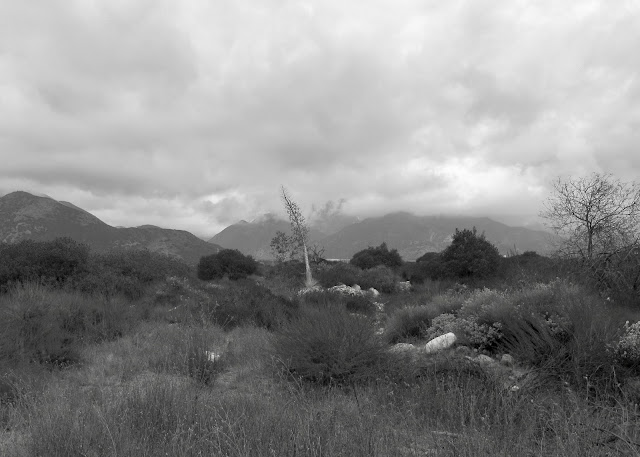Monday Blues: Stop, In the Name of the Law
Santa Fe, San Antonio, Cucamonga Canyon. Dams, one and all. The three are each of earthen construction and each was built as flood protection for the urban areas growing below them. Technically, I suppose, the most important purpose of each remains flood control, though I have never seen any of them holding all that much water in their wide-spread arms. What is the difference between the three? I don't mean engineering-wise, like how long, how tall, or how much water each is designed to hold back. Think more along the lines of everyday use.
Two of them are fully accessible by the general public for recreational use - we all can ride our bikes on and around them, we can walk our dogs, walk ourselves, push our babies in a stroller. We can picnic, fly a kite, play football, hide-and-seek; we can birdwatch, take photographs, run and jog, or ride horseback. We could gather the band-mates and hold an impromptu open-air concert. Pretty much anything you can think of doing, recreationally speaking, you can do at the Santa Fe and Cucamonga Canyon dams. Maybe you wouldn't choose to play football at Cucamonga Canyon; it is not really set up for that type of activity, but any of those other activities? Sure, and then some, no doubt.
Try doing any of those at San Antonio dam, on the other hand, and you are likely to be met by a representative of the Army Corps of Engineers telling you, as I was told yesterday, to turn around and leave, that you are trespassing.
But why? Why should two of the dams be designated okay for public recreation, and not the other one? Was it simply a matter of someone deciding this one would make a good public park, with no one proposing that another one would? If you have ever been to the Santa Fe Dam Recreation area you know how well used it is, particularly on the weekends, when hundreds or more cyclists, runners, walkers traverse the dam or use picnic areas down below. Though less formalized as a recreation area, Cucamonga Dam with the Cucamonga Creek Trail also attract numbers of walkers, runners, mountain bikers and gravel riders to share, with equestrians, rocky dirt routes through the wash, and up and over the dam. That, as a matter of fact, was the reason I was riding along below San Antonio Dam yesterday. It is a well-known all dirt route along the foothills between the two canyons (as well as other points further east and west). Denying access to the through route means runners and riders must use alternate routes along paved roads and streets, but for the failure of a government agency to recognize it as a recreation area.
The Inland Empire will, likely, continue to experience population growth for decades to come; the people already here, and those to arrive will need more space for both passive and active recreation. The San Antonio Dam, its basin, and the spreading grounds below should be in the cross hairs of any consideration to increase the availability of publicly accessible open space. The handfuls of people who pass through the area today are not the problem. No one I know is there to cause problems, the routes through the area are simply that - passages from one side of the canyon / wash to the other.
A few years ago I received some heresay information about talks to open the area to public use. Not wanting to compromise whatever discussions might have been taking place I never mentioned it. Maybe, though, we are at a point where a little nudge, if not a full on push, is required to get things moving. I seriously doubt that anyone is going to stop passing through the area, but would it not be nice to do so knowing that your simple run, or ride, is accepted rather than illicit?




Comments
Post a Comment